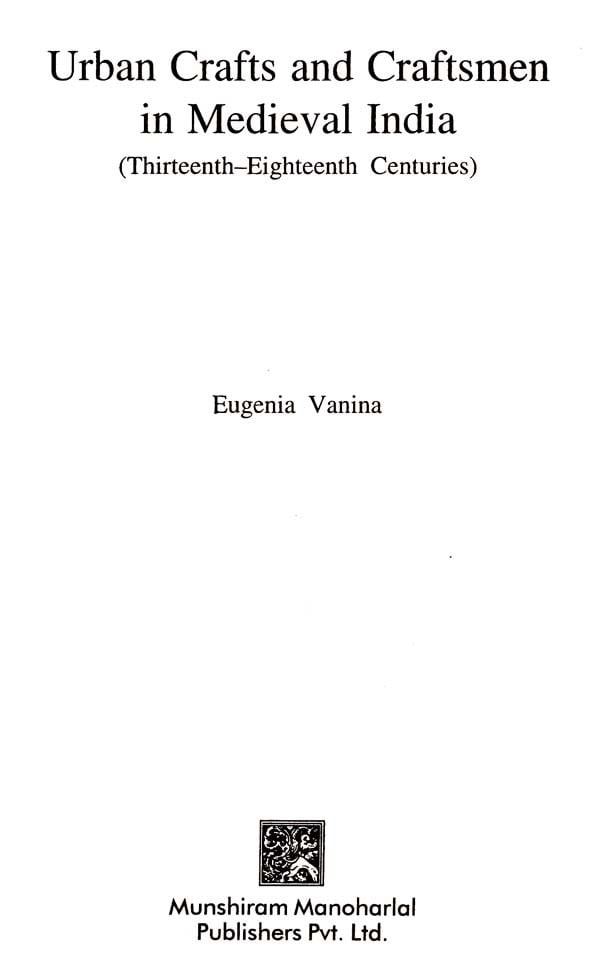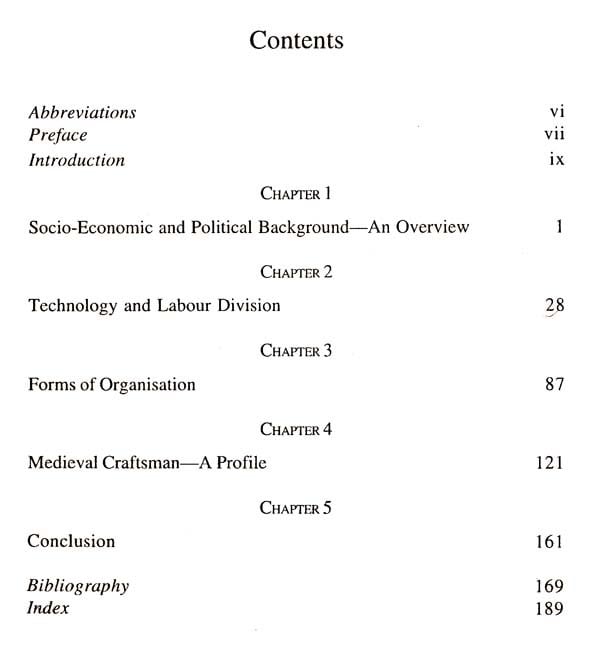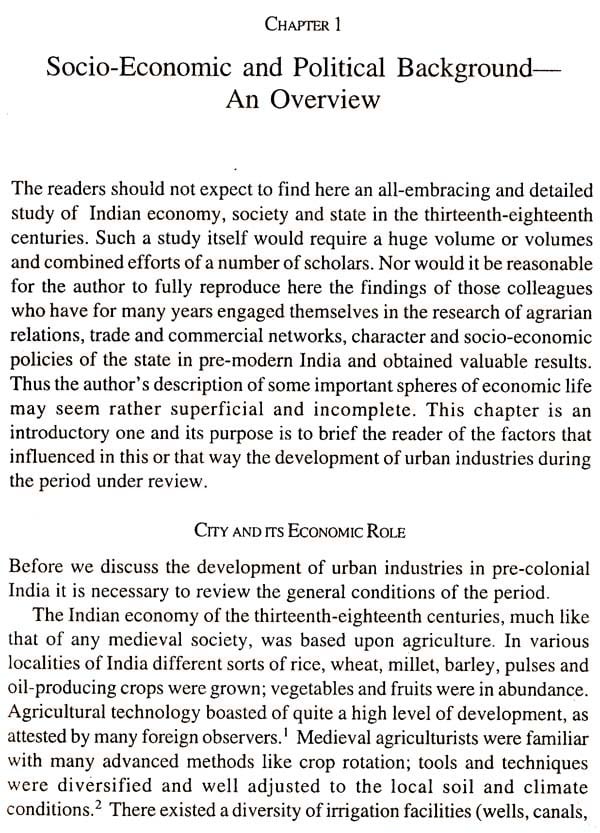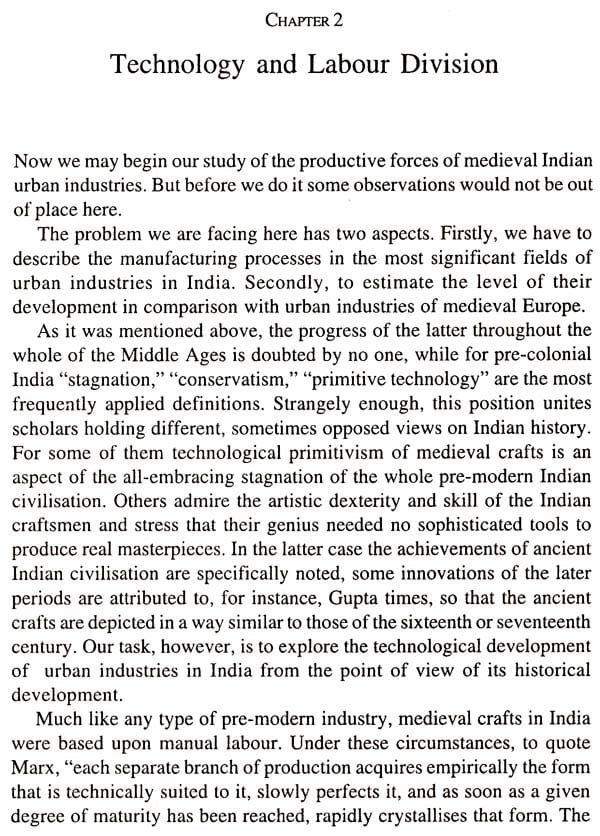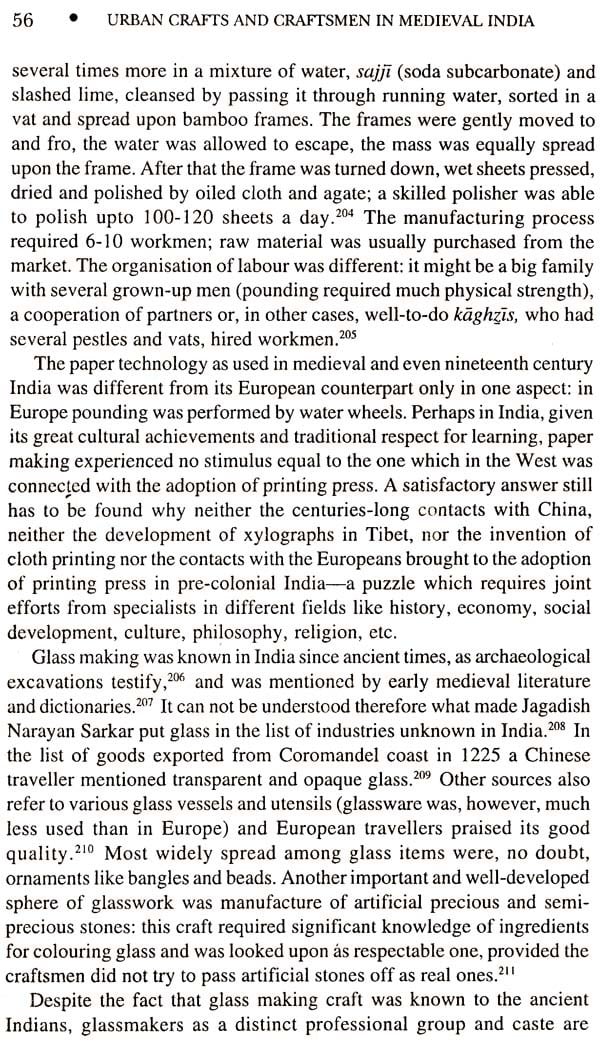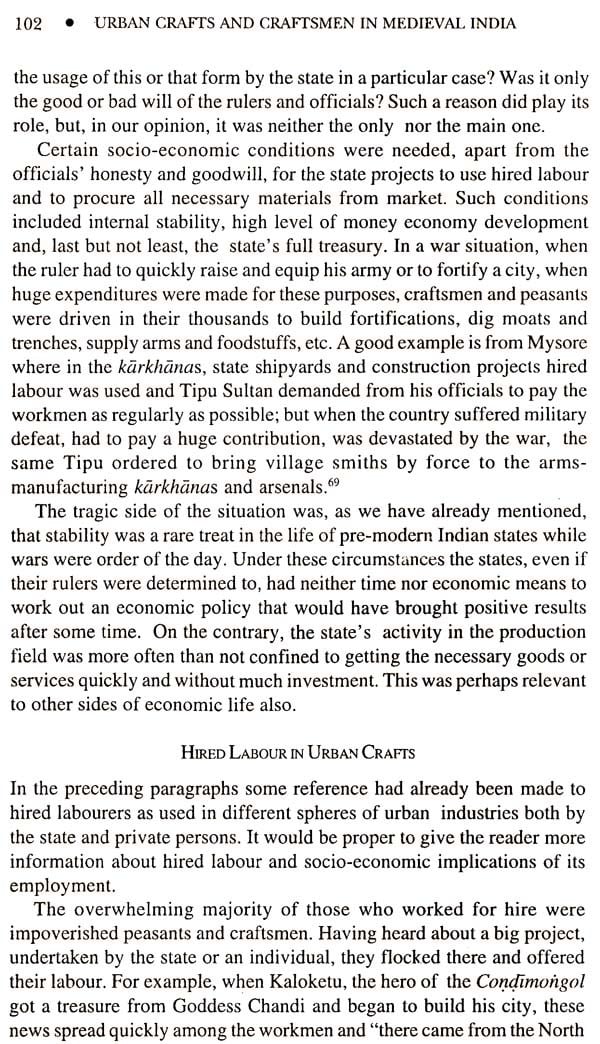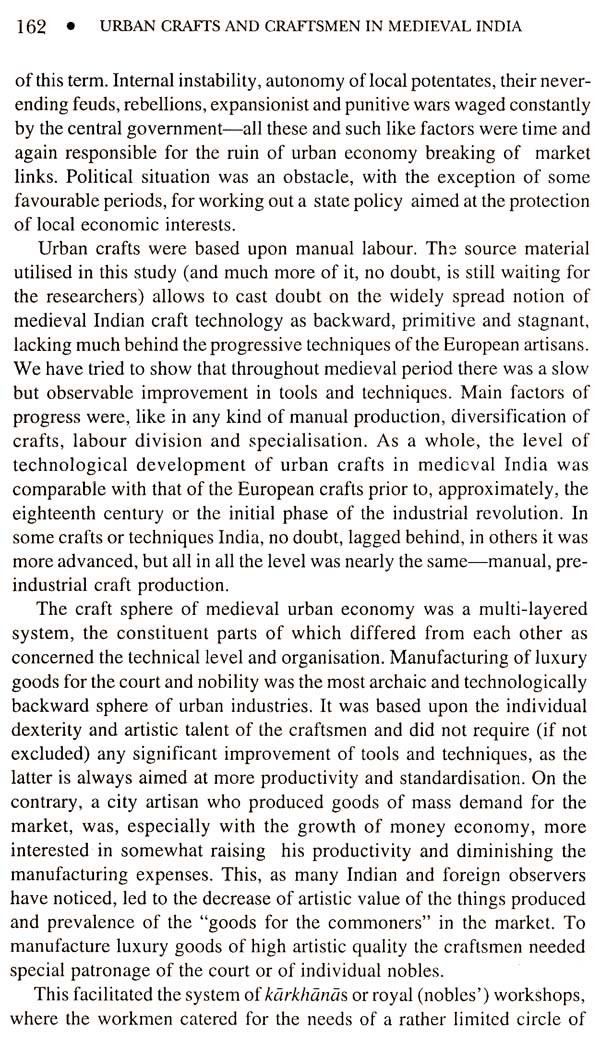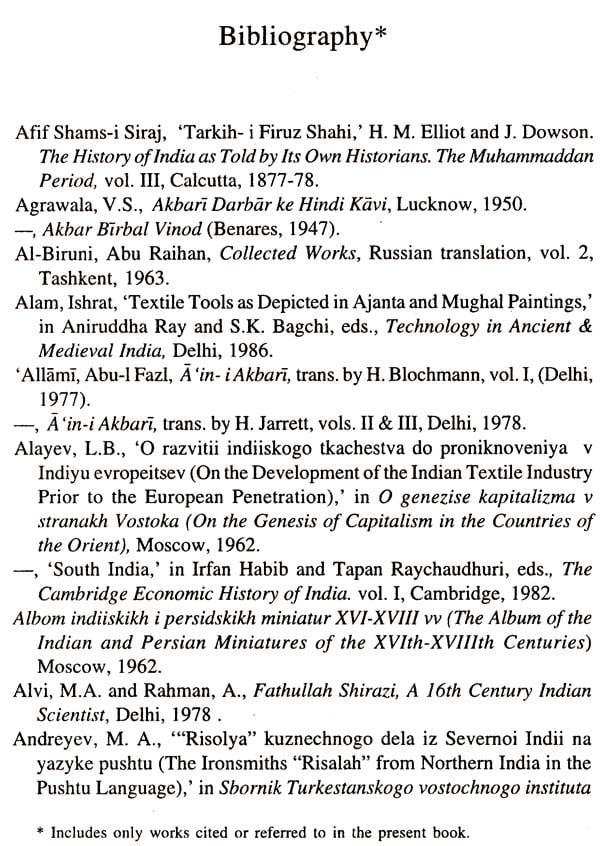
Urban Crafts and Craftsmen in Medieval India (Thirteenth-Eighteenth Centuries)
Book Specification
| Item Code: | UAP892 |
| Author: | Eugenia Vanina |
| Publisher: | MUNSHIRAM MANOHARLAL PUBLISHERS PVT LTD |
| Language: | English |
| Edition: | 2004 |
| ISBN: | 812151083X |
| Pages: | 223 |
| Cover: | HARDCOVER |
| Other Details | 9.00 X 6.00 inch |
| Weight | 440 gm |
Book Description
Urban Crafts and Craftsmen in Medieval India (Thirteenth-Eighteenth Centuries) discusses the development of non-agricultural production in pre colonial Indian cities. The author's purpose is twofold: firstly, to analyse the technological, organisational and social evolution of urban crafts in medieval India along with the economic and socio political atmosphere in which this sphere of production existed and, secondly, to compare the above-mentioned processes with their counterparts in other medieval societies, especially the better known European ones, and thus ascertain the level that India had achieved in this sphere by the beginning of colonial era.
Research material collected from various types of sources allows the author to critically re-assess the established notions of medieval Indian crafts as artistically exquisite but technologically backward and organisationally primitive. Comparative study of "stagnant" medieval Indian crafts vis-à-vis "progressive" European ones makes it possible to realise that in some industries or technological operations India did really lag behind, on others it was ahead, but all in all the level of technology and organisation achieved by urban industries of medieval India was approximately equal to what Europe had during the craft and even early stage of manufactory period. As far as general socio-political conditions are concerned, this juxtaposition, however, is not whely favourable for India.
No study of medieval crafts will be adequate if the researcher concentrates exclusively on technolo forms of organisation and economic relations, be forgets the people who were involved in these activities. Bearing this in mind the author undertakes the reconstruction of medieval craftsman's socio psychological profile and tries to denote the main features of his world outlook.
The book may be of interest to the scholars and students of medieval Indian history, especially its economic, social and cultural aspects, and to all those who, in their thoughts and researches, try to situate medieval India in world history.
Eugenia Vanina, born 1957, M.A. and Ph.D. from Moscow University, is Head, History and Culture Section, Centre for Indian Studies; Institute of Oriental Studies; and Russian Academy of Sciences. She is the author of Ideas and Society in India from the Sixteenth to the Eighteenth Centuries (Delhi, 1996), two books in Russian, a number of articles in Russian and English on various topics of medieval Indian history and also the editor of the volume Indian History. A Russian Viewpoint (Delhi, 2003).
Nearly 200 years ago, in 1805, a book was published in St. Petersburg. the then capital of the Russian empire. According to the fashion of that epoch, it had a lengthy title which may be translated from Russian as "An Impartial Observation of the Systems of East Indian Brahmans, Their Sacred Rituals and Popular Customs". This book was authored by G.S. Lebedev, a talented scholar, musician, writer and theatre producer, who had stayed in India in 1789-98.
The book, a first research work on India in Russian, offered the writer's countrymen a colourful and true picture of the eighteenth century Indian life. Unlike the majority of European Orientalists of the epoch, the Rus sian scholar was not only inspired by the classical heritage of ancient sages, but was highly appreciative of socio-economic and cultural life of his contemporary Indians. His attention was equally attracted to spiritual and mundane aspects of the Indian civilisation and, contrary to what other European observers of that epoch stated. Lebedev described eigh teenth century India as a land of vibrant commercial life and made a special emphasis upon industries and crafts which, according to him, were well developed, both from artistic and technological point of view.
Such statements by the beginner of the Russian national school of Indian studies pre-determined the interest of Russian academic circles and reading public in the material foundations of Indian civilisation. Socio-economic history, with special attention towards medieval and early modern periods emerged as one of the favourite topics of the Rus sian researches on India. The book hereby presented to the Indian readers belongs to this school, one of the oldest in Europe, and deals with the theme that has been, strange as it may seem, both extensively and inad equately researched upon either in Russia or in the West or India itself. Huge material has been accumulated by the generations of scholars, a number of high quality descriptive and analytical works are available. Nevertheless in this sphere a number of stereotypes, created by the aca demic traditions and ideologies of the bygone epochs, still rule supreme while the combined efforts of the scholars from a number of countries made many other fields of Indian studies free from them.
I hope that a Russian scholar's attempt to analyse and historically evaluate one of the most important spheres of socio-economic life in medieval India, i.e. the sphere of urban crafts, may be a modest contribu tion to the creation of a more true and historically veritable picture of India's medieval past that is by more than one link connected with its modernity. The author harbours no ambitions be an eye-opener or trail blazer: my purpose is to, firstly, research into urban crafts in pre-colonial India with special emphasis upon economic surroundings, technology, forms of organisation and socio-psychological profile of the artisans and, secondly, to evaluate the development of urban crafts in medieval India in comparison with their counterparts from other pre-modern soci eties, thus trying to ascertain the level that India had achieved in this sphere.
One of the most debatable topics of modern studies in Indian history is that of the level which the economy and society of the subcontinent had achieved in their evolution by the end of pre-colonial and the beginning of colonial era. The importance of this question needs no special explanation. To find an answer means to get the keys of so many enigmas and to form a more clear understanding of India's past, present and future. This is, no doubt, a complex problem which implies the analysis of economic development, social structure, the state and its functions, ideology, ethnic identities, religions, culture, etc. All these aspects are significant: the neglect of some of them or the exaggerated attention to another may distort the whole picture. Whether a scholar agrees with the "basis-superstructure" model or not, the research into socio-economic field will be of topmost priority.
The majority of works on this subject discuss the agrarian sphere of pre-colonial Indian economy, the development of agricultural techni ques, economic relations, social institutions and other sides of rural society as well as the state policies as concerned the peasants. Such an approach is fully justified by the fact that in all pre-modern societies, India being no exception, agriculture was the predominant field of economy and the occupation of the absolute majority of people. A number of Indian scholars, alongwith their colleagues from other countries, have made valuable contribution to the agrarian history of India.
**Contents and Sample Pages**
